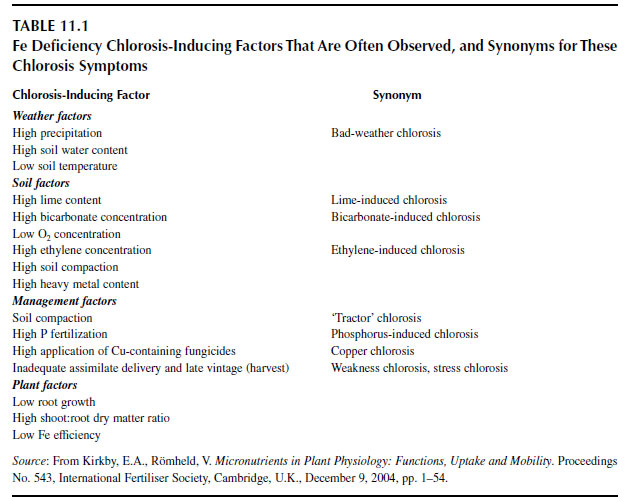Iron Requirement of Some Crops
Iron deficiency can be easily identified by visible symptoms, so this observation has made quantitative information on adequate concentrations of iron in plants more scarce (Table 11.1) (29). |
Furthermore, the so-called chlorosis paradox gives confusing results when critical levels are being determined. This confusion seems to be brought about by restricted leaf expansion due to shortage of iron, giving rise to similar concentrations of iron in the smaller, chlorotic leaves as in healthy green leaves (36). This paradox has been described in grapevine (Vitis vinifera L.) (37,38) and peach (Prunus persica Batsch) (39).
In general, the deficiency range is about 50 to 100 mg kg-1 depending on the plant species and cultivars (Table 11.2) (28). This range is somewhat complex to determine, as iron-efficient plant species are able to react to low availability of iron by employing mechanisms for its enhanced acquisition (see below), whereas iron-inefficient species are more dependent on adequate supplies of iron being readily available. In fact, it is apparent from simple calculations that plants must employ rootinduced mobilization of iron to obtain enough element for normal growth (28). Calculations based on the iron concentration of crops at harvest compared with the concentration of iron in soil water indicate an apparent shortfall in availability of a factor of approximately 2000, and calculations based on the iron concentration of crops at harvest and their water requirements indicate a shortfall of a factor of approximately 36,000. Both are very crude calculations, but they clearly indicate that the presence of plants, at least iron-efficient plants, makes iron more available in the soil than would be expected.
The data indicate a requirement of iron for an annual crop of 1 kg ha-1 year-1, but even for tree species the requirement is considerable. It has been estimated that for a peach tree in northeastern Spain, the amount of iron in the prunings in particular, but also lost in the harvested fruit, in leaf and flower abscission and immobilized in the wood, is between 1 and 2 g per tree per year (40).




